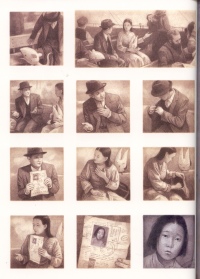| ________________
CM . . .
. Volume XIV Number 5 . . . . October 26, 2007
Shaun Tan’s book is, simply, spectacular. There are not enough superlatives to describe this innovative, evocative, challenging book. I have been waiting to get my hands on a copy for some time, and I was not disappointed. The Arrival is a stunning, groundbreaking wordless picture book/graphic novel. Although unpaged, The Arrival is 128 pages in length. Each of the countless monochromatic illustrations lends further layers of detail and intrigue to the book. Most of the illustrations have a sepia tinge to them, deliberately reminiscent of an old photograph. The Arrival is, after all, presented as if it is a battered old photograph album. Each of the book’s illustrations appears as if a photograph pasted into the album. The sequence of “photographs” relays the story of a migrant’s journey to a new land and the struggles that he encounters upon arrival—finding accommodation, locating sources of food, securing employment and, ultimately, his endeavours to bring his family to the new land. In these regards, it is the story that millions of immigrants have lived and, indeed, continue to live. What migrants do not typically encounter, however, are the bizarre, outer space like creatures that Tan litters throughout the book. Having said that, however, these discombobulating, mythical fantasy beings are clearly included as representative of the unnerving things that migrants do encounter upon arrival in a new land. Tan, himself the son of a migrant father who relocated from Malaysia to Australia, wants readers to live the migrant experience through his book. What environmental print does appear in the illustrations is not in English—indeed, I assume, not in any known language. Things like the maps, signs, books and passport information that the arrival encounters are all in an unknown language. This places the reader in the discomforting position of feeling that they might be missing something. Further, the mix of realistic, detailed, life-like images with their mythical, bizarre, additions further speaks to the immigrant experience. Just when things seem familiar, and comprehensible, one encounters something unexpected that devours whatever confidence might have blossomed for the migrant or, here, the reader. These things said, it would take a mature reader to appreciate fully the mastery of Shaun Tan’s work. It was with this in mind that I finally settled upon my grade six and up (ages 11 and up) designation for the book. I do, however, suspect this book can be enjoyed on many levels, and it is possible that even young readers can gain much enjoyment from the book. It is, after all, a wordless book. In keeping with the theme of the book, The Arrival definitely takes us where we in children’s literature have never gone before. Shaun Tan is a genius of the highest order. He is at the forefront of his field and with people like him thinking in such uniquely imaginative ways, there is no boundary to what the future of children’s literature potentially holds. The Arrival is attractively presented with hard cover and thick paper. At $24.99, I think the book is well priced. Indeed, I was pleasantly surprised to see that the retail price was not higher.
The range of illustrations in The Arrival is another of the many attractive book features. Some single illustrations are full, double-paged spreads. Elsewhere, a double-paged spread contains as many as 60 different images. In some places, we get many different perspectives from which to view the same location. The illustrations zoom in or withdraw from the scene. I do not claim to understand all that there is to understand in The Arrival. In fact, I believe that there is much in between the covers that is not meant to be understood. This represents and reflects the incomprehensible experiences and challenges that immigrants encounter. Given the multicultural make-up of Canadian society, this is an important book for Canadians. The Arrival provides opportunities for us to reflect upon our migrant experiences, or those of our forebears. The Arrival also potentially endows us with a greater empathy for those around us. I also cannot guarantee that all readers will enjoy The Arrival. On some levels, I am not sure that it is necessarily a book to be enjoyed. What it is, however, is a fascinating book. I believe that this is one for all households with an interest in literature for children. Highly Recommended. Gregory Bryan teaches children’s literature and literacy education courses at the University of Manitoba. Born in Australia, Bryan is a landed immigrant in Canada. He quickly learned what all that cold white stuff is that covers the Winnipeg ground for six months of the year.
To comment on this
title or this review, send mail to cm@umanitoba.ca.
Copyright © the Manitoba Library Association. Reproduction for personal
use is permitted only if this copyright notice is maintained. Any
other reproduction is prohibited without permission.
NEXT REVIEW |TABLE OF CONTENTS FOR THIS ISSUE
- October 26, 2007. AUTHORS
| TITLES | MEDIA REVIEWS
| PROFILES
| BACK ISSUES
| SEARCH | CMARCHIVE
| HOME |

